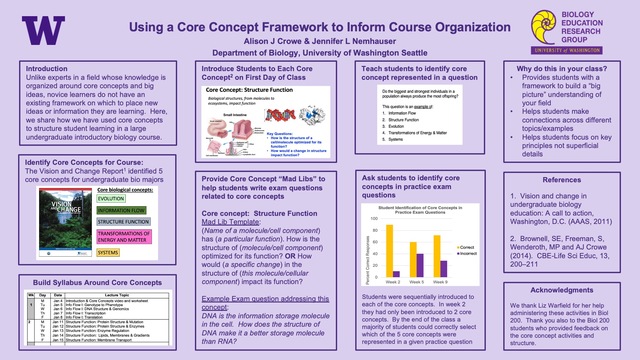Skip to main contentResource added 
To implement this approach, we first organized the topics in our course syllabus into core concept areas. In making our decision about which core concepts to focus on, we relied on a set of national recommendations for undergraduate life science education outlined in the NSF report Vision and Change. However, instructors in other fields can choose to focus on any established core ideas in their discipline. Students were introduced to these core concepts in the first week of class and each class period began with the instructor connecting that day’s learning goals to the core concept being addressed. To practice this skill, students worked in groups to identify core concepts addressed in a given scenario. Students continued to develop this skill in homework assignments where they identified core concepts in practice exam questions and in “exam wrapper” assignments where they reflected on whether their answers addressed the core concept being tested. As an additional study aid, we developed a set of “Core Concept Mad Libs” templates to help students write their own exam questions focused around each core concept. We assessed the effectiveness of this approach by measuring students’ ability to identify relevant core concepts in novel scenarios and their ability to develop high-level exam questions centered around these concepts.
By providing students with this conceptual framework, our goal is to help students recognize underlying concepts and organize newly learned information around these big ideas.
Using a Core Concept Framework to Inform Course Organization

Full description
Video Presentation
Authors:
- Alison Crowe, Biology, UW Seattle
- Jennifer Nemhauser, Biology, UW Seattle
Abstract:
Unlike experts in a field whose knowledge is organized around core ideas, novice learners do not have an existing framework on which to place new ideas or information they are learning. Every field has its own set of core ideas or major principles. Here, we share how we have used core concepts to structure student learning in a large undergraduate introductory biology course.To implement this approach, we first organized the topics in our course syllabus into core concept areas. In making our decision about which core concepts to focus on, we relied on a set of national recommendations for undergraduate life science education outlined in the NSF report Vision and Change. However, instructors in other fields can choose to focus on any established core ideas in their discipline. Students were introduced to these core concepts in the first week of class and each class period began with the instructor connecting that day’s learning goals to the core concept being addressed. To practice this skill, students worked in groups to identify core concepts addressed in a given scenario. Students continued to develop this skill in homework assignments where they identified core concepts in practice exam questions and in “exam wrapper” assignments where they reflected on whether their answers addressed the core concept being tested. As an additional study aid, we developed a set of “Core Concept Mad Libs” templates to help students write their own exam questions focused around each core concept. We assessed the effectiveness of this approach by measuring students’ ability to identify relevant core concepts in novel scenarios and their ability to develop high-level exam questions centered around these concepts.
By providing students with this conceptual framework, our goal is to help students recognize underlying concepts and organize newly learned information around these big ideas.
Poster PDF
View a PDF version of the poster in Google Drive to enlarge the image or download a copy.
Comments
The presenter for this poster will be available to respond to comments during Poster Session 1 on April 20, 2:00-2:50 p.m.Comments
to view and add comments.
Annotations
No one has annotated a text with this resource yet.
- typeImage
- created on
- file formatjpg
- file size590 kB
- publisherUniversity of Washington
- rights
Downloadable variants:


